Control+F
Booster Set 5
5.1 - Dragonic Overlord the End
5.2 - Phantom Blaster Overlord
Set 8
8.1 - Ultimate Dimensional Robo, Great Daiyusha
Set 9
9.1 - Blazing Lion, Platina Ezel
9.2 - Blue Storm Supreme Dragon, Glory Maelstrom
9.3 - Dragonic Kaiser Vermillion "THE BLOOD"
9.4 - Goddess of the Sun, Amaterasu
9.5 - Ultra Beast Deity, Iluminal Dragon
EB06
6.1 - Eternal Idol, Pacifica
BT11
11.1 - Hellfire Seal Dragon, Blockade Inferno
00.0 - Cross-Ride Assessment
00.0 - Cross-Ride Assessment
And so here's my views on each of the Cross-Ride's strengths. I will outline all their strongest or most favorable aspects of their skills, along with how their previous form and their respective decks function. As a little note, just by enabling its 13K defense, a Cross-Ride unit can save a lot of cards over the course of a match thanks to its huge defense, giving basically every Cross-Ride in existence an edge over most other units.
Booster Set 5

5.1 - Dragonic Overlord the End
The one that started it all, and oh boy was it insane.
Dragonic Overlord the End was a Persona Blast unit that could restand if it hit and paid 2 Counter-Blast, and oh god did this set up absolutely everything for it.
There are many different things that I personally think makes this unit absolutely flipping ridiculous, and not just its defensive capabilities as a Cross-Ride unit. As an on-hit unit ready from the get go immediately, Dragonic Overlord the End imposes an ever threatening pressure system on the opponent, so even if say you managed to miss Cross-Riding into it, you still would be generating more and more card advantage through the course of the match with almost no effort at all. At full power, its 21K Power, 20K forcing strikes also serve to absolutely destroy your hand far faster than that of a pressure unit that can only force 15K by requiring at least 2 10K shields per turn, already exceeding the average amount of shielding a player would normally generate once they have their Grade 3s up, forcing an overall deficit on your resources the longer it threatens you out. Its Persona Blast isn't even barely much of a restriction at all, since by turn 4, it's nearly a 2/3 chance to pull it off already, chances that I'm sure almost no one would ever risk to take.
Speaking of, you really never want it to hit. If the End can hit you and set off its Persona Blast, the immediate Twin Drive generates a +1 in card advantage for the the End player. On top of this, the next attack must be dealt with. While yes, it will most likely be much weaker than the 20K attack just prior, but the effects of Critical Triggers can carry over and add on to the ones the End can pull in its second attack, ultimately meaning you do not want that second attack to hit if you can help it. If the End can hit, it will generate at least a +2 in card advantage if you're forced to continue guarding it, or you will lose basically all leverage you have in a match from the +1 in card advantage the Persona Blast generates and the possibly doubly Crit-Boosted attack absolutely ruining any advantage you can generate from damage advantage.
Assuming you aren't crazy and/or your hand isn't already destroyed by the End's constant hazing, you will be losing at least a -1 in card advantage every turn from having to deal with the 20K guards through the midgame. Along with this, Cross-Ride defense can save up to another 2.4 cards per turn. With all these elements in place, the amount of Card Advantage the End can sum up will far outpace basically almost every other deck in the existence of this game. Except, it doesn't end here. While it's no Dragon Monk Goku deck, the amount of retire options the End has only exist to create even more leverage in a fight. Berserk Dragon, while slightly prone to clashing with the End, will generate raw advantage as you destroy a powerline. Kimnara's utility and flexibility can almost always be there to help you take down the opponent's forces. Heatnail Salamander can double up on roles, helping you either kill off annoying units on your opponent's field or creating a Rear-Guard pressure lane, even further wearing out the opponent's hand. Basically, if you require your Rear-Guards basically at all to secure your wins, you will stand absolutely no chance against the End.

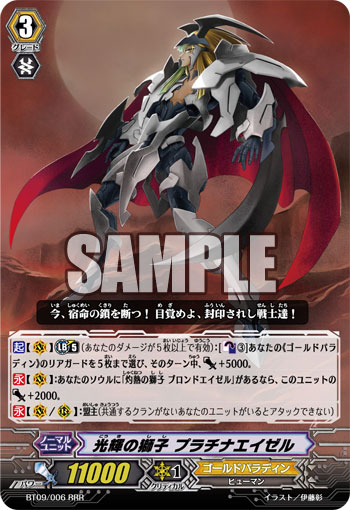



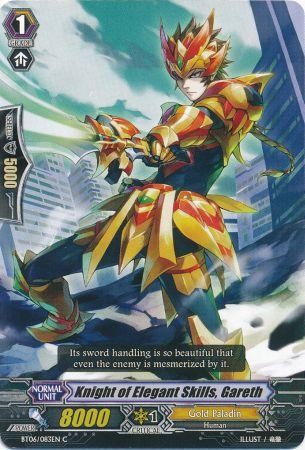



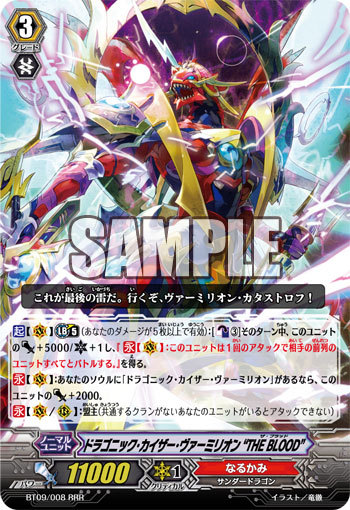
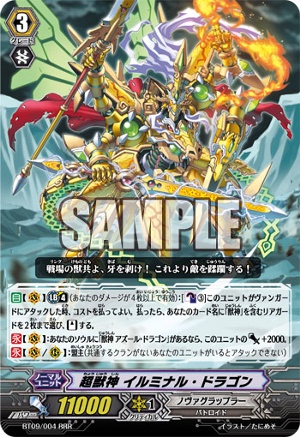

There are many different things that I personally think makes this unit absolutely flipping ridiculous, and not just its defensive capabilities as a Cross-Ride unit. As an on-hit unit ready from the get go immediately, Dragonic Overlord the End imposes an ever threatening pressure system on the opponent, so even if say you managed to miss Cross-Riding into it, you still would be generating more and more card advantage through the course of the match with almost no effort at all. At full power, its 21K Power, 20K forcing strikes also serve to absolutely destroy your hand far faster than that of a pressure unit that can only force 15K by requiring at least 2 10K shields per turn, already exceeding the average amount of shielding a player would normally generate once they have their Grade 3s up, forcing an overall deficit on your resources the longer it threatens you out. Its Persona Blast isn't even barely much of a restriction at all, since by turn 4, it's nearly a 2/3 chance to pull it off already, chances that I'm sure almost no one would ever risk to take.
Speaking of, you really never want it to hit. If the End can hit you and set off its Persona Blast, the immediate Twin Drive generates a +1 in card advantage for the the End player. On top of this, the next attack must be dealt with. While yes, it will most likely be much weaker than the 20K attack just prior, but the effects of Critical Triggers can carry over and add on to the ones the End can pull in its second attack, ultimately meaning you do not want that second attack to hit if you can help it. If the End can hit, it will generate at least a +2 in card advantage if you're forced to continue guarding it, or you will lose basically all leverage you have in a match from the +1 in card advantage the Persona Blast generates and the possibly doubly Crit-Boosted attack absolutely ruining any advantage you can generate from damage advantage.
Assuming you aren't crazy and/or your hand isn't already destroyed by the End's constant hazing, you will be losing at least a -1 in card advantage every turn from having to deal with the 20K guards through the midgame. Along with this, Cross-Ride defense can save up to another 2.4 cards per turn. With all these elements in place, the amount of Card Advantage the End can sum up will far outpace basically almost every other deck in the existence of this game. Except, it doesn't end here. While it's no Dragon Monk Goku deck, the amount of retire options the End has only exist to create even more leverage in a fight. Berserk Dragon, while slightly prone to clashing with the End, will generate raw advantage as you destroy a powerline. Kimnara's utility and flexibility can almost always be there to help you take down the opponent's forces. Heatnail Salamander can double up on roles, helping you either kill off annoying units on your opponent's field or creating a Rear-Guard pressure lane, even further wearing out the opponent's hand. Basically, if you require your Rear-Guards basically at all to secure your wins, you will stand absolutely no chance against the End.

5.2 - Phantom Blaster Overlord
Another one of the 'Big Three' from Set 5, Phantom Blaster Overlord is...lame.
Unlike the End's Persona Blast, Phantom Blaster Overlord can be played at any time under the player's discretion, meaning any pressure like effect it has on the opponent is close to naught. Now, 1 card for +10K power and a Critical isn't too bad of a deal, until it you remember it requires over half of your Counter-Blasts and the fact Perfect Guards exist. Honestly, at best it will force 10K more shield, hopefully 1 card, more out of the opponent. With your own -1 paying for the skill and assuming the opponent has no Perfect Guard, you're basically paying 3 Counter-Blasts to force 10K more shield out of the opponent in a break even. Woopdeedoo.
Of course, for its lame Vanguard skill, it does have some great quality support to back it up. Any lackluster units in your hand can easily be traded out for Raw Advantage through Nemain, and using Macha's skill will almost certainly prime your field for forward pushes. Along with this, you also have Nightmare Painter, who can be searched out by Macha to add Phantom Blaster Dragon from your hand to your soul. Played right, this basically means that instead of 3/4 of your matches that you ride into a Grade 3 by turn 3 to set up for Cross-Ride defense, almost all of your matches will have a tangible way to access your 13K defense without ridiculously reriding after riding up and then reriding again which is both time consuming and far too expensive to be worth your time.
Speaking of consistent edges, one must also remember that the Shadow Paladins have to sit over a Second Generation Ride Chain. While it's hard to really say how much using a Ride Chain improves your chances of riding without it becoming a case by case thing...again...the fact remains that despite the probability of the ride chain itself not being perfect, it still improves your overall chance to ride in at least some form. Combo this with how Blaster Javelin can search out a Peanut Butter Dragon for Nightmare Painter to shove into the soul, and you have the Cross-Ride deck that can really well exhibit what Paladins do best; generate card advantage that promotes consistency.
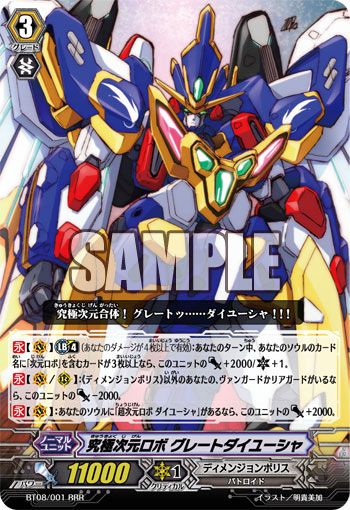

Ultimate Dimensional Robo, Great Daiyusha
Great Daiyusha is rather...
Okay, it's lame. With 10 Grade 1 Robos, 8 Grade 2s, and riding into the regular Daiyusha, Daiyusha will only be at full power only 50.9% of the time or 5 of the 8 games you get to Grade 3 at turn 3. And even if it's at full power, it also doesn't actually gain any more strength than any other Cross-Ride unless it attacks a 10K Vanguard with Glory Maker as your booster which, hint hint, means cutting your consistency even further. This basically means that Daiyusha's failure of being able to attack at full power consistently, and since at full power it's still quite lame, that Daiyusha is almost a failure of a card, if it weren't for its Cross-Ride defense.
Luckily, its support isn't so lame. Commander Laurel can help you generate even more card advantage by virtually making Daiyusha a pressure unit, allowing you to make Daiyusha as threatening as the End in a sense, which is quite a lot actually. Glory Maker is a ridiculously easy to activate 10K Vanguard booster, which allows it to hit other Cross-Rides for 20K forcing strikes, and 10-11K Vanguards even if you miss its Cross-Ride. Finally, Cosmo Beak can power up Daiyusha even further to create better attacks. With Glory Maker, a Cross-Ridden Daiyusha attacks to force out 25K on anything under 12K power, and a nonCross-Ridden Daiyusha will attack to force out 25K on a 10K Vanguard, and 20K from 12Ks and Cross-Rides. In tandem with Laurel's pressure system, and this card nearly can outpace Dragonic Overlord the End at its own game. Of course, needing multiple cards to go off rather than the End just having to be ridden, Daiyusha once again suffers in consistency in this aspect. Along with this, restanding the Vanguard again for a +2 but no Rear-Guard attacks, vs restanding the Vanguard for a +1 but still having Rear-Guard attacks, could line up far differently. In the end, you have a Vanguard with the possibility to be much more explosive than even the End that ultimately must suffer in consistency.

9.1 - Blazing Lion, Platina Ezel
The first of the three Ultimate Break units, Platina Ezel caught a lot of attention for its seemingly ridiculous skill.
Basically, with a field like:






Against a 10-11K Vanguard and at 13K power, the field has a B.a.s.s. value of 2120/49K(43.3K) shield, 228/49(4.7) cards. After Ezel's Ultimate Break, this value shoots up to 3345/49(68.3)K shield, 375/49(7.7) cards. Basically, +25K power, +3 cards with just one use of its skill, which for 3 Counter-Blasts is...impressive, however it can be alleviated by Perfect Guards and just letting attack through if you're not bound to lose. Meanwhile against a 13K Vanguard and/or Ezel is only at 11K power, the offensive strength of your attacks drops to 1875/49K(38.3K) shield (if you can make 18K rear-guard columns). While it's still a +25K in power to use its skill,
Now this unit has one major flaw, namely from the Ultimate Break restriction. Unless you want to run self damaging units, your opponent ultimately has control over whether or not they want to actually push you to this mark. Unlike Limit Break 4, which allows you your more powerful skills by the beginning of the late game, and thus must be pushed to by some point or else the opposing player will start losing a lot of Battle Advantage, Ultimate Break's 5 damage requirement can be easily abused. The simplest of these methods is to just hold you at 4 damage, with the opponent throwing their Vanguard at yours and acting out depending on how you respond. If you choose to guard, the opponent can send their Rear-Guard columns at your attackers, incapacitating your offensive for the next turn or further wearing out your hand. Along with this, if either of their checks was a Critical Trigger, the Critical can be passed to a Rear-Guard column for yet another expensive attack you will have to guard all out on, or risk losing. If you choose not to guard, the opponent's possibility of pulling a Critical Trigger can end the match right then and there. In fact, at 12 Crits and assuming their opponent runs 4 Heals that can go off, a Vanguard averages out to about 1.4 damage, very nearly a coinflip between 1 or 2 damage. I really hope I don't have to say why risking the entirety of your efforts in a match to a coinflip is horrendous. Even if you do survive, the probability of the attacker pulling any triggers at all is much higher than the probability of the defender pulling one, almost certainly meaning that having to deal with the Rear-Guard columns means that you basically must guard at that point, which can still continue to devastate your hand. Not to mention the metagame's increase of Vanguard's with skills or extra Crits to continue to punish you even further if they do hit at that point, which can completely ruin a fight for you from locking away your very ability to fight back.
In terms of support, this card isn't exactly BT05 material either. The best Gold Paladins really have to offer, at least at the time of BT09 is Garmore->Dindraine, and Spring Breeze Messenger(and Lop Ear Shooter). Of course, a dedicated Ezel deck would completely overrule the Grade 3 line up and take priority of the turn 3 ride, shutting off access to the former and arguably best Gold Paladin combo, which really only leaves Spring Breeze Messenger. While I don't really mean to downplay Spring Breeze Messenger's usefulness, standing alone in a virtually otherwise Vanilla deck really doesn't help bring out its strong points either, leaving Ezel here with a really plain base to work with. Overall, its Ultimate Break restriction and otherwise vanilla deck only really leaves a meh-tastic image of the card.

9.2 - Blue Storm Supreme Dragon, Glory Maelstrom
Attack first or attack 3rd?
If the former, you have a B.a.s.s. value of 2120/49K(43.3K) shield, 228/49(4.7) cards if attacking a 10-11K Vanguard while at 13K power. The latter however, only will force out 40K shield in the form of 4 cards, with a 5/49 chance to break a 2 to pass. On the other hand though, if you can somehow squeeze it into the deck, Benedict can raise this to 2120/49K(43.3K) shield, 223/49 (4.6) cards if attacking. While it is just barely less potent at wearing out your opponent's hand, doing so allows Maelstrom to hit Cross-Rides and 10-11K units if you were to miss out on Cross-Riding for this decent amount vs losing out on 5K shield otherwise, while also making its previous form not a vanilla, so let's just assume this R-R-V-R attack pattern.
Glory Maelstrom's Ultimate Break here gives it +5000 power, and the opposing player can't call Grade 1 or higher units to guard its attack. This attack also goes from requiring 20K shield to 25K shield for a 2 to pass, always requiring at least 1 more card, and making this card a technical +1. From a B.a.s.s. value point of view, this is actually quite tame at a +5K, +1 card, even if for 1 Counter-Blast. There is one huge twist though, which makes this card absolutely devastating. Being unable to guard with Grade 1 or higher cards lock you out of your 5K shields, meaning that (especially with the ever increasing use of 12 Crits) you can often have to overguard the attack for 30K shield, a +10K, +1 card. This card also locks out the use of a Perfect Guard, causing a huge jump from the possibility of only using 23.3K shield and a Perfect Guard and only using 4.6 cards, all the way to as high as 53.3K shield in the form of 5.6 cards all in one turn. Even if you decide to use the Perfect Guard on the last column, that's still 40K shield in the form of 6 cards in a turn, which is pretty flipping huge of a value, especially in the late game.

9.3 - Dragonic Kaiser Vermillion "THE BLOOD"
Instead of bullying just 10-11K Vanguards by using a Vanilla 8K booster with 13K power, Photon Bomber Wyvern just so happens to be flexible enough to allow Vermillion to attack 13K Vanguards when Cross-Ridden and 10-11K Vanguards when it isn't for a B.a.s.s. value of 43.3K shield, 4.7 cards. This only really leaves 1 situation for Vermillion to lag, when it misses its Cross-Ride and the opponent gets theirs, making it much more optimal that many more matches.
If you do get to use its Ultimate Break, the B.a.s.s. value increased by 5K shield and 1 card. This is almost completely mitigated by a Perfect Guard, but what's important to note is Vermillion's ability to attack the opponent's entire frontrow. This should almost always be an immediate -2 in card advantage for the opponent, often one that will strain resources if killing off Grade 2s or be destroying power lines if Grade 3s. Basically put, 1 use of its skill is a +5K shield, +3 in card advantage upon use. THE BLOOD here also has a plenty capable previous form of a Vanguard. Dragonic Kaiser Vermillion with its normal Limit Break restriction has a far greater range of utility, putting far greater emphasis on being able to level the opponent's frontrow down, hopefully earlier on, to keep the opponent's beaters and intercepts in check far earlier than THE BLOOD will ever have to deal with. Along with its ridiculous 10K booster and actually competent previous form, THE BLOOD also has access to Dragonic Deathscythe - albeit 1 shot - to further take down the opponent's field, like taking out an out of reach 10K booster.
9.4 - Goddess of the Sun, Amaterasu
Amatecrossu here is an on-hit Limit Break which, if it hits, can pay 2 Counter-Blast to add any Oracle Think Tank card you want from your deck to your hand. At its best, it can search out units like Silent Tom to completely defeat your opponent, or Chocolat to make sure your opponent can't break your guard for the turn. Except for one pesky little gimp, it's a Limit Break. As I've mentioned before, being a Limit Break totally ruins the entire driving force behind being an on-hit unit, virtually rendering this card a Vanilla Cross-Ride. Long story short, it's lame.
It does have a few redeeming factors however, all within its deck and support. Little Witch Lulu with its extra draw can give you even more of a defensive edge to couple with the 13K defense, and Godhawk Ichibyoshi up to Half Moon Tsukuyomi can set up a trigger stack in your deck, something Amaterasu's Soulcharge skill and Amatecrossu's tanking ability can easily make great use of. Along with the stack, Godhawk also gives Amaterasu better access to a second 12K attacker in the form of Tagitsuhime, virtually making any hassle associated with making 18K columns that much closer to obsolete, allowing better overall performance. Along with these 18K columns, Weather Girl, Milk can create a 23K Vanguard line with relative ease, making some generally all around great numbers to face 13K Vanguards. While it is far better suited for a 10-11K metagame, Silent Tom takes an honorable mention here, as with a single trigger will require the opponent to drop at least 2 cards on it, which coupled with say, Amaterasu's Soulcharging to Tsukuyomi's triggerstack, can be particularly devastating in a fight.

9.5 - Ultra Beast Deity, Iluminal Dragon
It's not Super anymore? Ehh...
For 3 Counter-Blasts, Iluminal Dragon's Limit Break can restand 2 Beast Deities for 2 more weaker attacks or one more stronger one. With a R-V-R-R attack pattern, or just restanding a single column, Iluminal Dragon raises the B.a.s.s. value by 10K shield and an extra card. With a R-R-V-R-R pattern, the value is a +2 in card advantage, however the shielding forced out is dependent on the opponent's Vanguard's power, and/or if they have intercepts to kill/are willing to guard their Rear-Guards. In all honesty, this card is also severely underwhelming in my eyes. For 3 Counter-Blasts, at best I can abuse attrition and turn the fight in my advantage, but as a one shot wonder during the late game where Beast Deities ultimately shut down in effectiveness, well...yeah. Unless you have the deckspace for units that can reliably unflip damage, the skill is rather heavy on its costing, something that fits far better as a pretty decent CB2 skill, but far too mediocre at CB3. Now, on the other hand, Beast Deities aren't that Counter-Blast heavy and shouldn't impede with the rest of the deck, however CB3 still locks you to usually one use, something that could be costly during the late game if this attrition based skill can't wear out the opponent in only one shot.
Despite its 1 shot nature, however, Iluminal Dragon is still a pretty decent unit, and has a lot of or will soon receive viable support. From its starters, White Tiger and Riot Horn both play really good roles. White Tiger can help progress midgame attrition, helping you gain that foothold earlier on in a match over the opponent, while Riot Horn can combo with restanders to further the assault. Just like White Tiger, Blank Marsh also plays the similar role of setting up pressure and setting up forward push, along with being in a deck full of 11K beatsticks means that 18K power lines are more than easy to reach.

6.1 - Eternal Idol, Pacifica
Pacifica's Limit Break takes a much nicer bound at 3 Counter-Blasts than Iluminal. Gaining an immediate +1 from the new unit, Pacifica also gains +5K shield (assuming the opponent has an intercept to retire), in the form of +44/49(0.9) cards from the new attack's B.a.s.s. value, virtually making it a +5K power, +1.9 in card advantage. This move also combos magnificently well with many Bermuda Triangle units. Including standard stuff like bouncing Rio to net even more plusses, units like PR♥ISM-Image, Clear and PR♥ISM-Promise, Celtic can push the B.a.s.s. value even further for even bigger hand draining attacks.
While Pacifica's 3 Counter-Blast is just a little expensive for the deck, she comes with a great set of support to help supplement her advances. Already mentioned are bounce targets Rio, Clear, and Celtic, all of which offer much more utility in their draw and power boosts respectively. Along with these units, bouncers like Weddel, Mona, Tyrrhenia, and the Pearl Sisters can all work to further push these combos. Weddel can trade out for a new draw, or push a column to force 5K more shield in exchange for the 5K boost. Mona can force the bounce skills to activate and generate advantage. Tyrrhenia, after you consider that behind Pacifica will be attacking for 18K against other Cross-Rides, can initiate more bounces without burning Counter-Blasts. Finally, under the threat of falling behind in card advantage, the pressure the Pearl Sisters create can continue to generate card advantage even without having to actually hit.
Pacifica's support has just one major flaw, many of its key cards can't create 18K columns well. While the deck would have no problem faring in a 10-11K metagame, the most important units to really make the deck the most effective it can be being unable to create proper powerlines can be detrimental to the deck's overall ability.
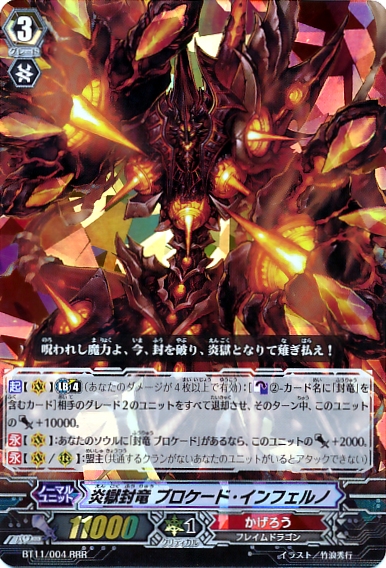
For 2 Seal Dragon Counter-Blasts, Blockade's Limit Break retires all Grade 2s on your opponent's field, and Blockade gains +10,000 power. Assuming an intercept on the opponent's field, this sort of skill pushes to force out 15K shield and gain a +2 in card advantage out of it, which for 2 Counter-Blasts, is pretty good actually. I'll be assuming you can only use it once though, for reasons soon to be explained. However, because of the one shot nature behind Inferno, the opponent really shouldn't have a problem canceling out the brunt of what the skill can do with a single Perfect Guard, especially due to the opponent having few moments beforehand that would require it. With just one, the skill slows down to force out an immediate 5K shield in the form of a +1. For 2 Counter-Blasts and killing one unit, this sounds about right, until we note that it only kills Grade 2s. Due to the ability to intercept and if the opponent isn't a scrub, they will immediately go out of their way to call Grade 3s to the frontlines. Eventually, this could mean that Blockade's skill can simply go all for naught, having virtually no effect over the opponent in a match.
Luckily, there are ways around running into a complete derp. Seal Dragons Terrycloth and Corduroy both have skills that allow you to force Grade 2s onto the opponent's field. Against a standard deck with 11 Grade 2s and no notable deck manipulation, about 10545/30268 or 34.8% of the time will the opponent not actually be able to call a Grade 2. This basically makes Terrycloth a -0.7 instead of an immediate -1 entirely from its skill, and Corduroy an immediate +0.3. Of course though, the opponent still has the option to intercept, meaning that if you really want to combo them with Blockade Inferno, you're going to have to use Inferno immediately after the two. With either, Blockade itself will average to be a +0.7, +3.3K shield. Now, keep in mind, altogether, it could be 3 Especial Counter-Blasts just to break even in the case of Terrycloth, or make a standard +1 with Corduroy. Basically, it's ridiculously costed for a mediocre Limit Break combo, and almost comes out as the best the deck can offer. There is a way to really make it effective but...
Blockade's previous form has the ability to lock down interceptors from intercepting. Almost always trapping down an intercept if you were to ride it at turn 3, you can use it through the midgame to hold down intercepts for Blockade Inferno's skill to really be useful. Actually, you must do so. The entirety of making Blockade Inferno's skill useful through the normal Blockade's skill is to entirely give up your 13K defense throughout the fight. Yes, your field jamming is far more potent once you have set up like this, but Blockade's abusable 10K base and the increasing power of Rear-Guards and once again giving up defense means that for just as much leverage Inferno can make, advantage is loss or placed severely underwhelmed from the regular Blockade.
While Pacifica's 3 Counter-Blast is just a little expensive for the deck, she comes with a great set of support to help supplement her advances. Already mentioned are bounce targets Rio, Clear, and Celtic, all of which offer much more utility in their draw and power boosts respectively. Along with these units, bouncers like Weddel, Mona, Tyrrhenia, and the Pearl Sisters can all work to further push these combos. Weddel can trade out for a new draw, or push a column to force 5K more shield in exchange for the 5K boost. Mona can force the bounce skills to activate and generate advantage. Tyrrhenia, after you consider that behind Pacifica will be attacking for 18K against other Cross-Rides, can initiate more bounces without burning Counter-Blasts. Finally, under the threat of falling behind in card advantage, the pressure the Pearl Sisters create can continue to generate card advantage even without having to actually hit.
Pacifica's support has just one major flaw, many of its key cards can't create 18K columns well. While the deck would have no problem faring in a 10-11K metagame, the most important units to really make the deck the most effective it can be being unable to create proper powerlines can be detrimental to the deck's overall ability.

11.1 - Hellfire Seal Dragon, Blockade Inferno
Luckily, there are ways around running into a complete derp. Seal Dragons Terrycloth and Corduroy both have skills that allow you to force Grade 2s onto the opponent's field. Against a standard deck with 11 Grade 2s and no notable deck manipulation, about 10545/30268 or 34.8% of the time will the opponent not actually be able to call a Grade 2. This basically makes Terrycloth a -0.7 instead of an immediate -1 entirely from its skill, and Corduroy an immediate +0.3. Of course though, the opponent still has the option to intercept, meaning that if you really want to combo them with Blockade Inferno, you're going to have to use Inferno immediately after the two. With either, Blockade itself will average to be a +0.7, +3.3K shield. Now, keep in mind, altogether, it could be 3 Especial Counter-Blasts just to break even in the case of Terrycloth, or make a standard +1 with Corduroy. Basically, it's ridiculously costed for a mediocre Limit Break combo, and almost comes out as the best the deck can offer. There is a way to really make it effective but...
Blockade's previous form has the ability to lock down interceptors from intercepting. Almost always trapping down an intercept if you were to ride it at turn 3, you can use it through the midgame to hold down intercepts for Blockade Inferno's skill to really be useful. Actually, you must do so. The entirety of making Blockade Inferno's skill useful through the normal Blockade's skill is to entirely give up your 13K defense throughout the fight. Yes, your field jamming is far more potent once you have set up like this, but Blockade's abusable 10K base and the increasing power of Rear-Guards and once again giving up defense means that for just as much leverage Inferno can make, advantage is loss or placed severely underwhelmed from the regular Blockade.
00.0 - Cross-Ride Assessment
If I had to rate them from best to worst, it would look generally like this for the following reasons in a Cross-Ride metagame:
1. Dragonic Overlord the End automatically takes the top spot. With utility units to retire troublesome Rear-Guards and a pressure based skill that can only generate advantage, the rest of the metagame is near incomparable to the End.
2. Daiyusha also has the sort of pressure system that makes the End so threatening, however consistency is the favored element of a competitive setting, and it lacks retiring capabilities, so it falls just short. Glory Maker also allows Daiyusha to push out just that much more out of Cross-Rides, which helps give Daiyusha an edge in terms of raw power.
3. Dragonic Kaiser Vermillion, like Daiyusha, has Rapid Fire Wyvern for extra power against other Cross-Rides. Along with this, its Ultimate Break restriction means it has no trouble sparing 2 CB to pay for Dragonic Deathscythe, something that could take out an opponent's own 10K Vanguard booster that's giving Vermillion trouble. Vermillion also has one of the best previous forms of most of these Vanguards. While The Blood's skill in and of itself is lame and generally far from your reach, the support it has more than allows it to compete optimally.
4. Hellfire Seal Dragon, Blockade Inferno's Limit Break is far too gimmicky to truly work, and the Seal Dragon support it has to supplement it is poor overall. Luckily, in general Kagero support is Kagero support. While not as outright powerful as Vermillion without a 10K Vanguard booster, Blockade has access to far more retirers like Kimnara and Heatnail Salamander, giving it a decent defensive edge and far more opportunities to take out the opponent's troublesome +8K units.
5. Phantom Blaster Overlord is the most consistent of the Cross-Rides to maintain its 13K defense, giving it a pretty good advantage over every other Cross-Ride to come after. Its support, at least in Nemain and Macha, also don't directly suffer from 13K base, making it an overall stable Cross-Ride.
From this point on, the Cross-Rides after all generally have lackluster support, and/or their skills just don't make up for much, virtually making them vanilla Cross-Ride decks which, in a Cross-Ride meta, will fall flat.
From a 10-11K metagame:
1. Dragonic Overlord the End
2. Ultimate Dimensional Robo, Great Daiyusha
3. Eternal Idol Pacifica
4. Phantom Blaster Overlord
5. Ultra Beast Deity, Iluminal Dragon
With the End and Daiyusha keeping their place, the latter actually a bit better now, Eternal Idol comes up with its own support now no longer invalidated by the inability to make proper powerlines. Along with this, her own Limit Break is no longer hindered from the new Rear-Guard being unable to hit an opposing Vanguard, and the raw advantage the support as a whole can create far outpaces many of the other Cross-Ride decks. Phantom Blaster Dragon also moves up, thanks to Macha creating an instant 16K column for its offensive capabilities, or set up Charon behind the Vanguard circle for a well set 21K Vanguard column. Finally, Ultra Beast Deity, Iluminal Dragon's Limit Break for 2 more attacks can go to force out far more out of the opponent and do quite a bit more than what the rest can do.
And so are my views of the Cross-Rides...alright, let the comments about how someone likes ______ Cross-Ride and that it's so great.
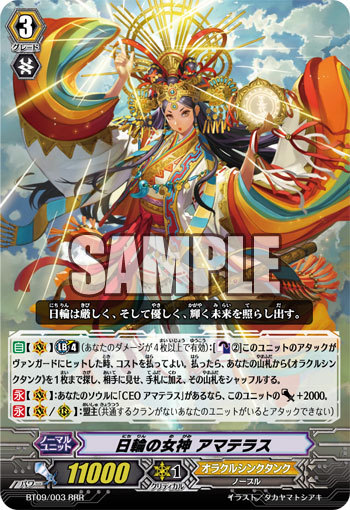
I like Amaterasu crossride it is so great.
ReplyDeleteOBJECTION!
ReplyDeleteI find Inferno much more viable then you say:
Your plan is to shut down field scaling with Blockade until LB, then crossride inferno to reap benefits.
My idea is just to ignore the shutdown and instead focus on getting Infero ASAP. My reasons:
1) The limit break skill is self-sufficient: The 10000 POWER is broken into two stages, 5000 for Limit Break (Found in Garmore and such) and 5000 for the counterblast (Zerchiel, Dragonic Descendent or something). Any rearguards retired is a direct plus as the costs supplement the power and not the retirement.
2) The Limit Break can also remove 12k attacks aimed for a 18k column.
3) Corduroy and Terrycloth targets 18k columns and/or Laurels so you an abuse the 13k base. This is why Kagero is so good at crossrides, bewing able to shut down any 18k columns keeping their card advantage for a LOOONG time. Kagero has all the pieces to both push offensively and restrict defensively.
1. The Limit Break itself is not really self sufficient. As I mentioned, it's hard to really expect the opponent to just keep Intercepts on their field for the entirety of a match if they know you use Inferno, so if you abandon shutting down Intercepts and abusing the Seal Dragons, oftentimes that 10K power is all you get. And once again, the opponent has very few reasons to drop Perfect Guards otherwise, which could easily cancel out that power boost. The only way for advantage generated is for a Rear-Guard to be retired, and therefore the +1 you payed for. With a competent opponent, that's probably not happening :\
Delete2. Great, Berserk Dragon could've done that too, except it can also go off during the midgame where it might have made a greater difference, and that alone for a Vanguard skill is still mediocre.
3. The End has the offensive push. Inferno, not so much. This may make a huge difference if Inferno was able to suddenly drop a crapload of power over the opponent's head in the late game, but it doesn't. Instead, now it's mostly just a stall game waiting for whoever gets their better Limit Break off first.
I'm not saying its better then DOTE. Just better then THE BLOOD, because you have THE BLOOD 3rd and Inferno 4th. Inferno is much better at limiting crossride hitting columns then Narukami.
Delete2) I was just screwing around with this point. I wanted 3 points.
I wasn't saying it was better, but you too quickly generalized the entirety of Kagero having an offensive push, when most of it stems from their boss units. The End was just the most extreme example.
DeleteOn the other hand, then make sure you actually sound like you're trying to one up The Blood with your arguments. Let's try again:
1) Both units' Vanguard skills are plain useless. One from actually being useless, the other rarely ever having a moment to go off.
3) Terrycloth is also a minus for you a majority of the time, while almost all of Narukami support stays at break evens or direct plusses, for example Berserk Dragon. Once again assuming you're abandoning regular Inferno, Corduroy isn't really doing much at all to really mess with the opponent quite frankly, and any job it can do is far better done by Dragonic Deathscythe, or Berserk Dragon. In fact, quite frankly, they'd both be even in this respect. Both Vanguards' skills are unreachable and both have similar support. The only breaks are, if you ignore other Seal Dragons entirely, Kagero has more utility retirers in Kimnara and Heatnail Salamander. On Narukami, Photon Bomber Wyvern allows Vermillion to consistently hit 23K, which can be very important in a Cross-Ride meta. However, the entire point of Kimnara and Heatnail Salamander is very close to going all for not, as there will rarely be a scenario where the opponent can outright one up your own columns. Virtually making the only edge Kagero has over Narukami, those utility retires, useless, a Narukami based deck specifically The Blood in this case would outpace Inferno.
There's also the matter that between offense and defense of the same value, generally this game favors offensive plays, but ehh. It's not like the defensive value compares to the offensive one in the first place anyway.